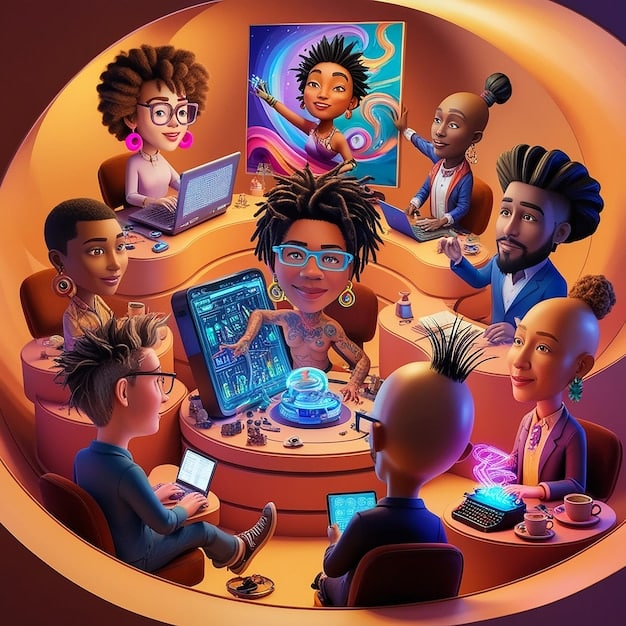Metaverse for US Businesses in 2025: Opportunities & Challenges

Understanding the metaverse presents both significant opportunities, such as enhanced customer engagement and new revenue streams, and considerable challenges, including regulatory uncertainties and technological hurdles, for US businesses in 2025.
The metaverse, a persistent, shared, 3D virtual world, is rapidly evolving, presenting a new frontier for businesses. Understanding the Metaverse: Opportunities and Challenges for US Businesses in 2025 is crucial for strategic planning and future growth.
What is the Metaverse and Why Should US Businesses Care?
The metaverse is more than just virtual reality; it’s a convergence of physical and digital realities, creating immersive experiences. For US businesses, understanding its potential impact is paramount.
It represents a paradigm shift in how consumers interact with brands, offering new avenues for engagement, commerce, and innovation.
Defining the Metaverse
The metaverse is best understood as a network of 3D virtual worlds focused on social connection. Users can interact, work, create, and transact within these digital spaces.
Potential Impact on US Businesses
The adoption of metaverse technologies may have a significant influence on how US businesses operate, from marketing strategy to workplace environment, driving increased revenue streams.
- Enhanced customer experiences: Immersive engagement leading to higher customer loyalty.
- New revenue streams: Virtual products, digital real estate, and metaverse-based services.
- Remote collaboration: Enhanced tools for virtual meetings and teamwork, increased productivity.
- Brand building: Unique storytelling and impactful advertising opportunities.

By embracing the metaverse, US businesses can stay ahead of the curve, connect with customers in innovative ways, and create sustainable competitive advantage.
Key Opportunities for US Businesses in the Metaverse
The metaverse provides tangible opportunities for US businesses across various sectors. From retail to education, the potential applications are diverse and transformative.
Early adopters are positioning themselves to capitalize on these emerging trends, gaining a competitive edge in a rapidly evolving digital landscape.
Enhanced Customer Engagement
The metaverse allows businesses to create interactive and immersive experiences that foster greater customer engagement. Virtual stores, interactive product demos, and personalized avatars enhance the customer journey.
New Revenue Streams
The creation and sale of digital assets, virtual real estate, and metaverse-based services offers businesses opportunities. These new revenue streams can diversify income and increase profitability.
- Virtual products and collectibles: Digital versions of physical goods, virtual accessories, and limited-edition collectibles.
- Digital real estate: Virtual land ownership, development, and rental opportunities.
- Metaverse-based events and experiences: Virtual concerts, conferences, and product launches.
- Subscription services: Access to exclusive content, virtual communities, and premium experiences.
By leveraging these opportunities, US businesses can drive revenue growth and create value for customers in the metaverse.
Challenges and Risks of Metaverse Adoption
While the metaverse presents exciting opportunities, it also poses certain challenges and risks that US businesses need to address. Navigating these issues effectively is critical to achieving success.
Regulatory uncertainties, technological limitations, and cybersecurity risks are among the factors that demand careful consideration and strategic planning.

Regulatory Uncertainties
Existing laws and regulations may not adequately address the unique aspects of the metaverse. Intellectual property rights, data privacy, and consumer protection are areas of concern.
Technological Limitations
Current technological infrastructure may not be able to support the growing demands of the metaverse. Bandwidth limitations, hardware requirements, and interoperability issues can hinder adoption.
- Scalability: Ensuring the metaverse can handle a large number of users and transactions simultaneously.
- Interoperability: Enabling seamless interaction and data exchange between different virtual worlds and platforms.
- Accessibility: Ensuring the metaverse is accessible to users with varying technical skills and equipment.
By proactively addressing these challenges, US businesses can mitigate risks and ensure a successful entry into the metaverse.
Preparing Your US Business for the Metaverse in 2025
Preparing for the metaverse requires a strategic approach that encompasses technology, talent, and business models. US businesses must take proactive steps to ensure readiness.
Investing in relevant technologies, developing necessary skills, and exploring innovative business models are crucial for success in the metaverse.
Investing in Relevant Technologies
Businesses should invest in technologies like VR/AR, blockchain, and AI to build capabilities in the metaverse. These technologies are essential for creating immersive experiences and enabling secure transactions.
Developing Necessary Skills
Developing a skilled workforce is critical. Training employees in areas like 3D design, virtual world development, and blockchain technology will allow them to fully leverage the opportunities in the metaverse.
Exploring Innovative Business Models
In order to drive growth and maintain competitiveness, businesses should explore business models. Businesses can tap into a wide variety of new revenue streams and customer engagement strategies by experimenting with new models.
By taking these steps, US businesses can position themselves for sustainable success in the metaverse.
The Role of E-E-A-T in Metaverse Business Strategies
E-E-A-T (Experience, Expertise, Authoritativeness, Trustworthiness) plays an important role in fostering trust and credibility in the metaverse. Businesses prioritize creating great content and experiences, which helps build customer loyalty.
In the metaverse, demonstrating E-E-A-T will be vital for establishing credibility and differentiating from competitors. E-E-A-T ensures brands are reliable and trustworthy in the virtual world.
Experience
Demonstrating real-world experience in a relevant industry can help establish trust with customers. Businesses can also offer immersive experiences and interactive product demos so customers can easily understand and grasp the brand and have a positive experience.
Expertise
Showcasing expertise through thought leadership and content creation contributes to perceived authority. Businesses can collaborate with recognized experts and influencers to communicate valuable information.
- Publishing high-quality, informative content: Create engaging and valuable learning experiences.
- Engaging industry experts: Collaborate with opinion leaders to share best practices.
- Showcasing successful implementations: By highlighting how a business has excelled in the metaverse, people will be more likely to engage.
By actively pursuing E-E-A-T, US businesses can build trust, demonstrate value, and establish credibility in the metaverse.
Future Outlook: The Metaverse in 2025 and Beyond
The metaverse is expected to continue its rapid evolution, becoming more integrated into everyday life. Looking ahead to 2025 and beyond, the opportunities for businesses are expected to grow.
Advancements in technology, increasing user adoption, and evolving regulations will shape future growth of the metaverse.
Continued Growth and Adoption
The number of users, use cases, and investment in the metaverse are likely to increase. As the infrastructure expands, so will the business and consumer opportunities.
Technological Advancements
Advancements in all technologies that enable virtual reality such as augmented reality, and artificial intelligence should continue. All of the advancements enable the experience to be more immersive and accessible.
Evolving Regulations
Governments and regulatory bodies may establish clear guidelines and regulations for the metaverse which will influence operations and business opportunities. These regulations will help shape ethical standards and protect consumers.
Overall, the future of the metaverse is promising, with sustained growth, technological advancements, and evolving regulations shaping the landscape for US businesses.
| Key Point | Brief Description |
|---|---|
| 🚀 Metaverse Definition | A network of 3D virtual worlds that evolve |
| 💰 Revenue Streams | Includes digital products (collectibles) and real estate |
| 🛡️ Challenges | Regulatory uncertainty and technological limitations are the primary challenges. |
| 🔑 Key to Success | Adopting E-E-A-T by creating valuable, customer centered experiences. |
[FAQ]
Frequently Asked Questions (FAQ)
▼
The Metaverse can be described as a digital reality that combines aspects of social media, online gaming, augmented reality (AR), virtual reality (VR), and cryptocurrencies to allow users to interact virtually.
▼
The metaverse represents a shift in how customers engage with brands, offering new channels for commerce and innovation. US businesses can stay competitive by embracing these new opportunities.
▼
The adoption of the Metaverse comes with several challenges, including regulatory uncertainties, technological limitations, cybersecurity risks, and scalability issues. It is critical for businesses to manage these and mitigate their effect.
▼
US businesses can prepare themselves by investing in technologies such as VR/AR, blockchain, and AI. It is equally important to develop the workforce’s competence by providing training in these areas.
▼
E-E-A-T (Experience, Expertise, Authoritativeness, Trustworthiness) is essential for building trust and authority in the Metaverse. E-E-A-T ensures that brands are consistent and reliable in the virtual world.
Conclusion
As US businesses look ahead to 2025, understanding the metaverse and preparing for its opportunities and challenges will be crucial for sustained growth and competitiveness. By embracing the transformative potential of the metaverse and mitigating its risks, businesses can unlock new possibilities and shape the future of commerce.



![Quantum Computing for Beginners: A US Geek's Guide [2025] Quantum Computing for Beginners: A US Geek's Guide [2025] - Cover Image](https://dorama2you.com/wp-content/uploads/2025/06/dorama2you.com_3_1749769492_79bdbcc1_cover-360x180.jpg)

